Are you noticing small bugs buzzing around your fruits and vegetables in the kitchen? You might be dealing with fruit flies, a common household nuisance. Don’t worry, getting rid of these tiny flies is easier than you think and doesn’t require expensive solutions or harsh chemicals. In fact, you likely have everything you need to create effective traps right in your kitchen.
Like many homeowners, we recently experienced a fruit fly invasion. This unexpected situation presented the perfect opportunity to test various methods for eliminating them. After thorough experimentation and careful notes, we’re excited to share the best DIY fruit fly traps and prevention strategies.
These homemade traps are incredibly easy to assemble using natural ingredients you probably already have. If you prefer a humane approach, these traps can also be designed to release the fruit flies outdoors instead of eliminating them. Beyond traps, we’ll also cover essential tips to prevent fruit fly infestations from happening in the first place.
Understanding Fruit Flies: Are They the Tiny Flies You See?
Fruit flies are indeed those small flying pests frequently seen hovering around ripe fruits and vegetables – their name is quite descriptive! They are also attracted to sugary and fermented drinks like beer, wine, and juices. You’ll often find them congregating near fruit bowls, trash cans, and even kitchen drains.
About the size of a grain of rice, fruit flies resemble small, tan or brownish houseflies, often with distinctive red eyes. They are most prevalent during summer and late fall, coinciding with fruit harvesting seasons.
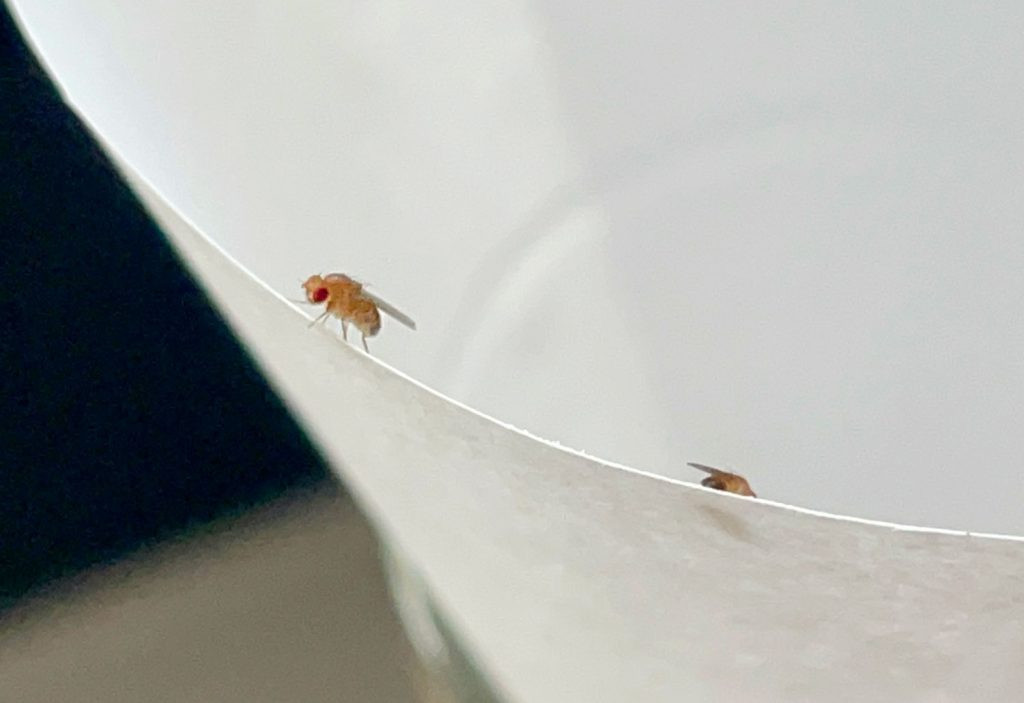 Close Up Of Fruit Fly On Paper Funnel
Close Up Of Fruit Fly On Paper Funnel
A fruit fly problem can start with just a few bugs brought inside on fresh produce. However, female fruit flies can lay hundreds of eggs in their short lifespan, and these eggs can hatch in as little as 12 hours. They mature into adults within days, meaning a small number of these pests can quickly escalate into a large infestation. This rapid reproduction cycle underscores the importance of addressing a fruit fly problem promptly.
Identifying Your Tiny Flies: Fruit Flies vs. Fungus Gnats vs. Drain Flies
It’s easy to mistake fruit flies for other small flying insects commonly found indoors, particularly fungus gnats and drain flies. While all are small and winged, accurate identification is crucial for choosing the most effective removal method. The easiest way to differentiate them is by observing their location and noting which larger insect they resemble.
- Fruit Flies: Look like miniature flies. As mentioned, they are typically found around fruit bowls, garbage, and food waste.
- Drain Flies: Resemble small, fuzzy moths. As their name suggests, they are usually seen near sinks and drains.
- Fungus Gnats: Look like tiny mosquitoes. They are commonly found near houseplants because they breed in damp potting soil.
If you’re uncertain about the type of tiny flies you’re dealing with, try one of the traps described below. If it attracts the pests in your home, you’re likely dealing with fruit flies.
4 Simple DIY Traps to Get Rid of Tiny Flies
Getting rid of tiny flies, specifically fruit flies, doesn’t have to be a complicated or expensive endeavor. You likely already have the necessary supplies at home, and the process is quite straightforward. Each trap operates on the same basic principle: attract the fruit flies and prevent their escape. We tested four different DIY methods and found a clear winner. However, since each method uses common household items, trying more than one is easy and worthwhile. Think of it as a fun science experiment to reclaim your kitchen from these tiny invaders! Here are the four methods we tested:
- Funnel Trap
- Plastic Wrap Trap
- Dish Soap Trap
- Rotting Fruit Trap
Let’s delve into the details of each method, and we’ll share our findings on their effectiveness. Keep in mind that some traps work faster than others, and it may take a few days to completely eliminate your fruit fly problem, regardless of the technique you choose.
#1: The Paper Funnel Trap for Tiny Flies
This trap method uses a paper funnel to guide fruit flies into a container. The narrow opening at the funnel’s bottom makes it easy for them to enter but difficult to exit.
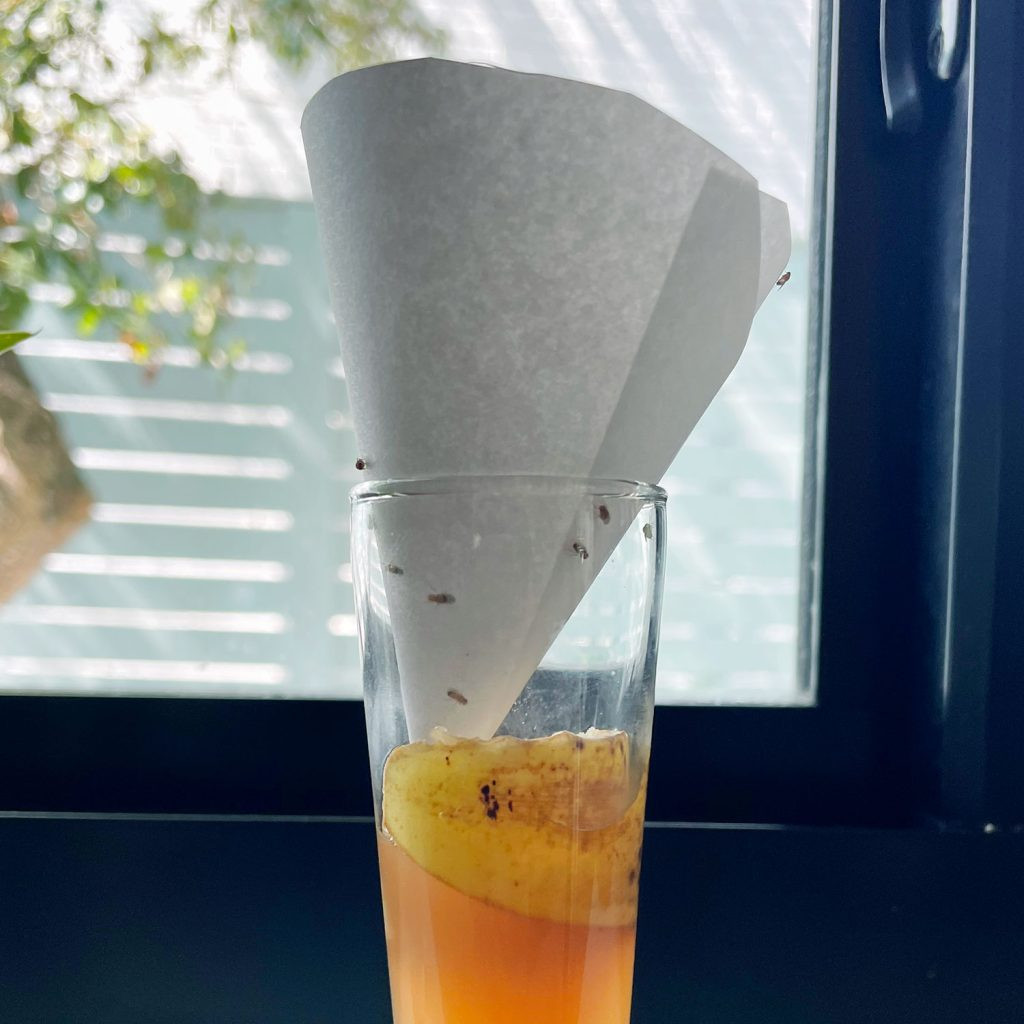 DIY Fruit Fly Trap With Paper Funnel
DIY Fruit Fly Trap With Paper Funnel
Supplies you’ll need:
- A small, clear jar, cup, or container – a narrow opening is preferable.
- A sheet of paper or cardstock.
- Tape.
- Scissors.
- Apple cider vinegar (ACV).
Instructions:
- Select your container: Choose a small, clear container such as a repurposed food jar or a plastic bottle. A narrow opening is advantageous for this method.
- Add apple cider vinegar: Pour a small amount of apple cider vinegar, old beer, or wine into the container’s bottom. These liquids’ enticing scent will attract the fruit flies.
- Create the funnel: Roll a piece of paper or cardstock into a cone shape, ensuring a very small opening at the tip. Secure the cone’s shape with tape. You can also cut the tip opening after forming the cone if that’s easier. The opening only needs to be about the size of a grain of rice.
- Position the funnel: Place the paper funnel into the container’s opening. You might need to adjust the funnel’s shape so it rests securely on the opening’s edge without touching the apple cider vinegar. Ensure there are no gaps between the funnel and the container’s opening where flies could escape.
- Humane removal option (optional): Carefully take the entire trap outdoors, being cautious not to disturb the funnel (or the flies will escape before you get outside). Once outside, remove the funnel to allow the trapped fruit flies to fly away.
While you can use a store-bought funnel, the opening might be too large, allowing trapped fruit flies to escape. A homemade paper funnel offers a more customizable and effective opening size.
#2: Plastic Wrap Trap to Catch Tiny Flies
Similar to the funnel trap, this method uses apple cider vinegar as an attractant. Fruit flies enter through small holes poked in a plastic wrap covering but struggle to find their way out.
Supplies you’ll need:
- Small, clear jar, cup, or container.
- Rubber band.
- Plastic wrap or a plastic bag.
- Toothpick.
- Apple cider vinegar (ACV).
The steps for creating this plastic wrap trap are very similar to the funnel trap method:
- Choose your container: Select a small, clear jar, cup, or any glass container. The size isn’t critical, and clarity helps you monitor your trap’s success. An old can or opaque container will also work.
- Add apple cider vinegar: Pour apple cider vinegar into your container. Its scent will lure the fruit flies. Old beer or wine also work effectively, but avoid regular white vinegar as it’s less attractive to fruit flies.
- Cover with plastic wrap: Tightly stretch plastic wrap over the container’s opening and secure it firmly with a rubber band. Saran wrap or a piece cut from a plastic bag will work.
- Poke small holes: Use a toothpick to carefully poke a few small holes in the plastic wrap. You don’t need many holes, but ensure they are large enough for a fruit fly to enter.
- Humane removal option (optional): Carefully carry the trap outdoors without removing the plastic wrap cover (to prevent escape). Once outside, remove the plastic wrap to release the trapped flies.
Alternatively, you can create a similar trap using a metal jar lid. Use a mason jar or an old food jar with a metal lid. Carefully puncture a small hole in the lid using a hammer and nail.
#3: Dish Soap Trap for Getting Rid of Tiny Flies
This trap method differs from the previous two as it doesn’t require a cover. Instead, it uses the surface tension of soapy water to trap the flies. Important note: This method doesn’t allow for humane removal, as the soap will coat and trap the flies.
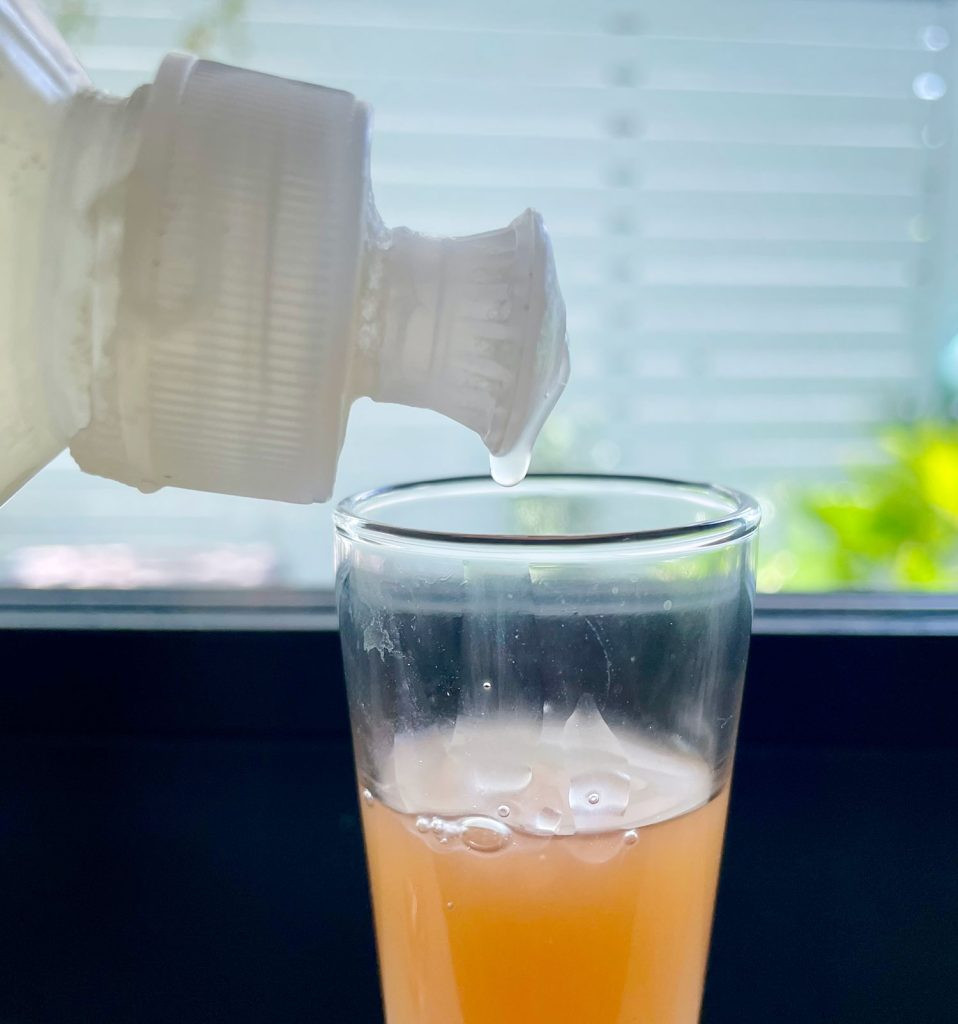 Dripping Dish Soap Into Apple Cider Vinegar For DIY Fruit Fly Trap
Dripping Dish Soap Into Apple Cider Vinegar For DIY Fruit Fly Trap
Supplies you’ll need:
- Small container, bowl, or dish.
- Dish soap.
- Apple cider vinegar (ACV).
The instructions for this trap are incredibly simple:
- Pour apple cider vinegar: Fill the bottom of your chosen container with apple cider vinegar. The scent will attract the fruit flies.
- Add dish soap and mix: Add a few drops of dish soap to the apple cider vinegar and gently mix. The soap breaks the surface tension, so when fruit flies land on the mixture, they will sink and become trapped.
This technique can also be combined with the plastic wrap or funnel trap methods for enhanced effectiveness. Adding dish soap to the apple cider vinegar before covering the container provides an additional trapping mechanism.
#4: Rotting Fruit Trap for Tiny Flies
We also experimented with traps that use fruit itself as the lure, capitalizing on fruit flies’ strong attraction to ripe and decaying fruit.
Supplies you’ll need:
- Small glass jar, cup, or container.
- Plastic wrap or paper funnel (depending on your chosen trap style).
- A small piece of overripe fruit, such as a banana peel or apple slice.
To create a rotting fruit trap, simply replace the apple cider vinegar in either the Plastic Wrap Trap or Funnel Trap with a piece of banana peel, apple slice, or peach. You can also enhance the attractant by adding a fruit scrap to your apple cider vinegar in any of the trap methods. However, be mindful that fruit scraps will need to be replaced every day or two to prevent unpleasant odors in your kitchen.
The Most Effective Trap for Tiny Flies: Our Verdict
As shown in the photos, we set up four different DIY traps to compare their performance in catching fruit flies. Our tested traps combined different techniques:
- Plastic Wrap Trap with banana peel.
- Funnel Trap with ACV and banana peel.
- Plastic Wrap Trap with ACV and dish soap.
- Dish Soap Trap with ACV.
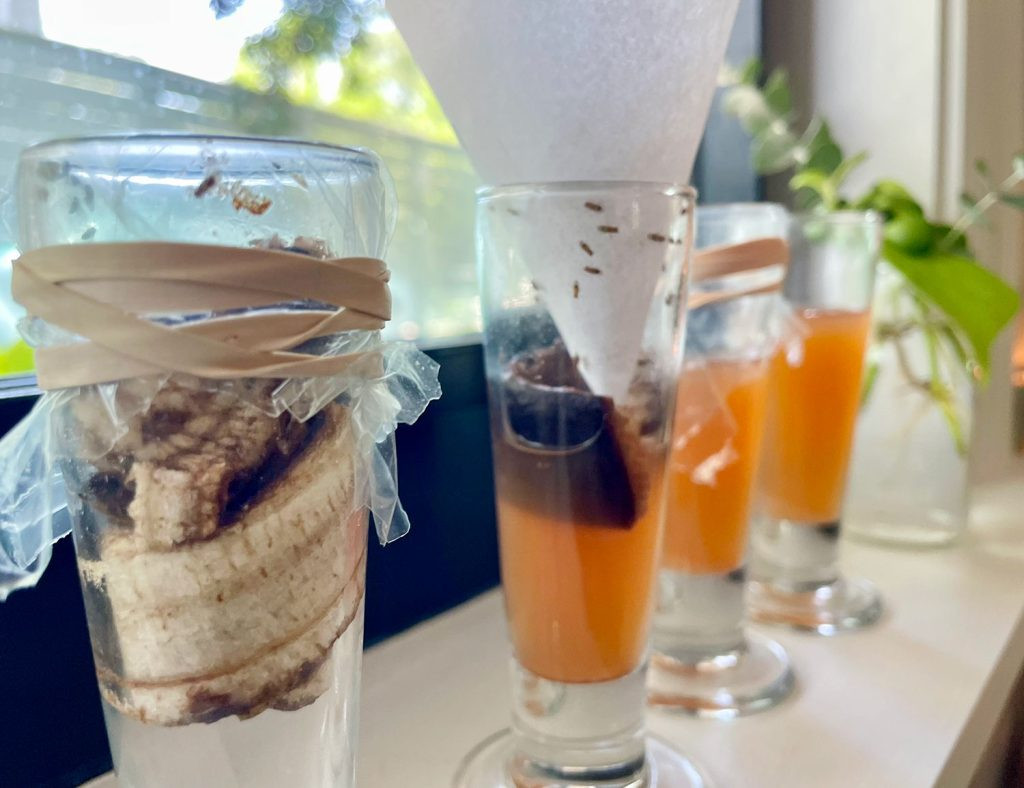 4 DIY Fruit Fly Traps Close Up
4 DIY Fruit Fly Traps Close Up
Our results indicated that the lure was more critical than the trap type. Traps using banana peel significantly outperformed those using only apple cider vinegar. The two Plastic Wrap Traps were almost identical in design, but the one baited with banana peel captured dramatically more fruit flies than the ACV and soap trap. It seems apple cider vinegar is less appealing when real fruit is nearby.
Therefore, our primary recommendation is: Regardless of the trap style you choose, add a piece of fruit to it! We slightly preferred the Plastic Wrap Trap due to its ease of construction and stability. We accidentally knocked over the funnel trap once, releasing some flies back into the kitchen – oops!
What Attracts Tiny Flies the Most? Experimenting with Lures
Our success with fruit scraps inspired us to further investigate which type of fruit is the most effective bait. We tested three readily available fruits: banana peel, apple slices, and a strawberry. Each was placed in a Plastic Wrap Trap and set side-by-side on our countertop for 24 hours.
While the banana peel initially seemed promising (being the ripest at the start), fruit flies were most attracted to the strawberry. The banana peel still caught a good number of flies, but the strawberry’s effectiveness increased as it ripened further. Interestingly, the apple slices didn’t attract any fruit flies in our test!
Store-Bought Fruit Fly Traps: An Alternative
If DIY solutions aren’t working for you, or if you prefer a ready-made option, several effective store-bought fruit fly traps are available. These traps have generally positive reviews and are typically priced under $20. They might be worth considering if you need to trap other types of flying insects or prefer a more discreet trap design.
 Collage of Storebought Fruit Fly Traps
Collage of Storebought Fruit Fly Traps
During our experiment, we also purchased a pack of Terro Fruit Fly Traps to compare their performance against our homemade traps. We placed a Terro trap next to our banana and strawberry traps for 24 hours.
Again, our homemade strawberry trap performed best, closely followed by the banana peel trap. The store-bought trap only caught a single fruit fly in the initial 24-hour period. HOWEVER…
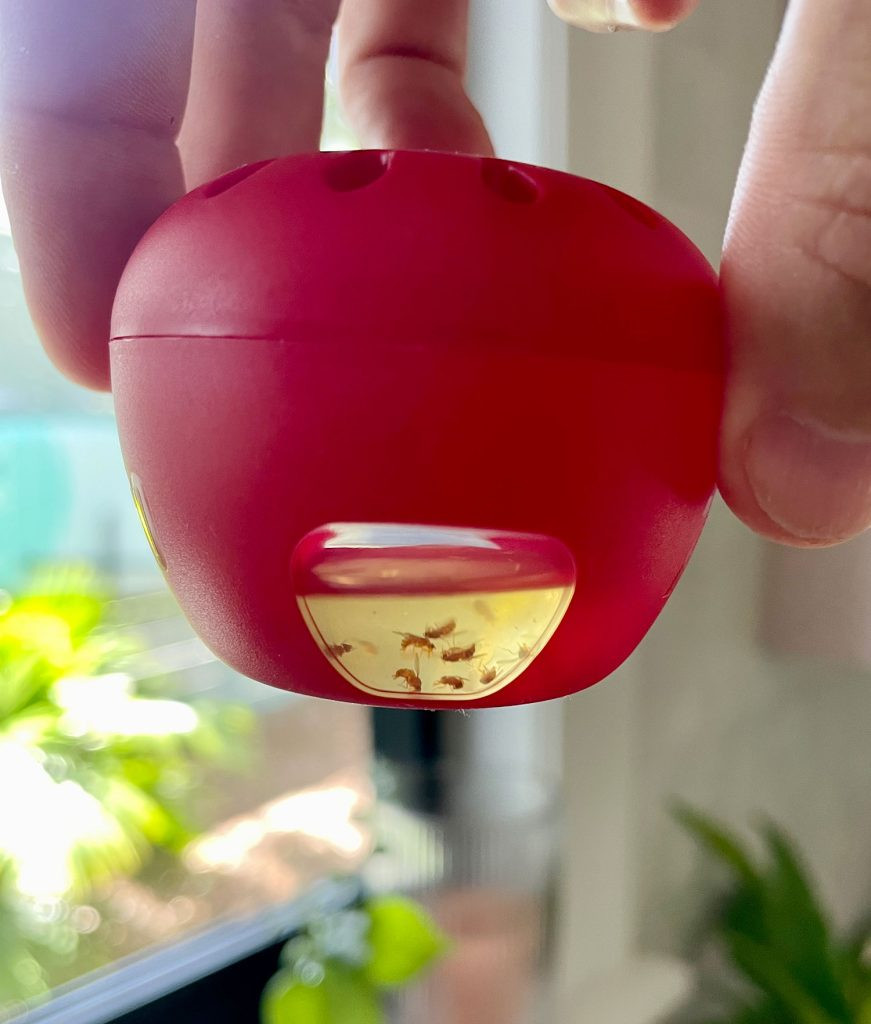 Terro Fruit Fly Trap With Dead Fruit Flies Visible
Terro Fruit Fly Trap With Dead Fruit Flies Visible
To ensure a fair comparison, we removed our DIY traps and left only the store-bought Terro trap out for another 24 hours. Over this extended period, it captured a significant number of fruit flies. So, store-bought traps are effective, but they might not work as quickly or as efficiently as homemade traps in the initial stages of an infestation. Our conclusion? Store-bought traps are a good option if you prioritize discreetness, especially for long-term placement. However, homemade traps are often the quickest and most effective solution for immediate fruit fly control!
Preventing Tiny Flies: Key Strategies
While eliminating fruit flies is relatively simple, preventing them from infesting your home in the first place is the ideal approach. Here are simple preventative measures you can take:
- Maintain clean kitchen surfaces: Regularly wipe down kitchen counters, stovetops, tables, and any surfaces that might accumulate food residue or liquid spills. Fruit flies are strongly attracted to fruit, sugary liquids, and alcohol, so keep these areas clean!
- Regularly empty your trash: Food scraps left in your garbage can quickly become a breeding ground for fruit flies, especially overnight.
- Promptly discard overripe fruit: Monitor your fruit bowl for fruits that are becoming overripe or starting to rot (like browning bananas or apples). Dispose of them before they attract fruit flies.
- Wash produce immediately after bringing it home: Washing fruits and vegetables as soon as you get them home from the store can eliminate any fruit fly eggs or larvae that might be present (except for berries, as moisture can accelerate their spoilage).
- Refrigerate produce when possible: Fruit flies don’t thrive in cold temperatures. When in doubt, store your fruits and vegetables in the refrigerator to deter them.
- Clean your sink drain regularly: Food particles trapped in your sink drain can also attract fruit flies. Run your garbage disposal and/or flush the drain regularly to prevent buildup.
Finally, remember not to panic if you spot fruit flies in your home. While it’s important to act quickly to prevent the problem from worsening, the solutions presented here are easy, effective, and fast-acting. You might even find yourself enjoying the process of becoming a fruit fly scientist, just like we did!
*This post contains affiliate links, so we may earn a small commission when you make a purchase through links on our site at no additional cost to you.